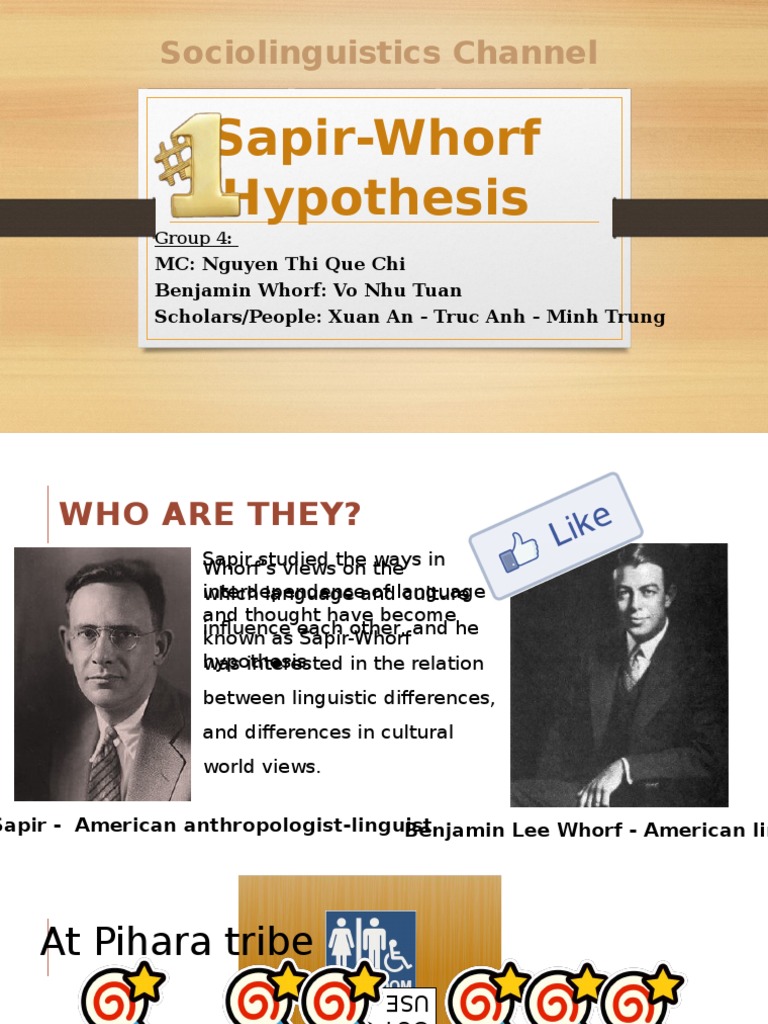The Sapir-Whorf hypothesis, a seminal concept within the realms of linguistics and cognitive science, posits that the structure and lexicon of a language influence the ways in which its speakers perceive and conceptualize reality. This fascinating theory, articulated by linguists Edward Sapir and Benjamin Lee Whorf, has engendered a comprehensive array of interpretations and variants, each shedding light on the intricate interplay between language, thought, and culture. A nuanced exploration of these versions illuminates how language transcends mere communication, becoming a vessel for cultural identity and a determinant of cognitive patterns.
One of the primary iterations of the Sapir-Whorf hypothesis is often categorized into two distinct forms: linguistic determinism and linguistic relativity. Linguistic determinism, the more extreme version, posits that language confines and determines thought. In this perspective, the inability to articulate specific concepts in a language implies an incapacity to think about those concepts. For instance, if a language lacks a term for ‘blue,’ its speakers may be unable to perceive or differentiate shades of blue. Conversely, linguistic relativity suggests a less rigid relationship, positing that language influences thought and perception but does not entirely constrain it. This variant allows for the possibility that while language shapes habitual thought patterns, it does not inhibit the flexibility of the human mind. The careful consideration of these two interpretations unveils the multifaceted relationship between language and cognition.
In examining the implications of linguistic relativity, one observes its resonance in diverse cultural contexts. For example, the Hopi language, spoken by a Native American tribe, has been a focal point in discussions surrounding the Sapir-Whorf hypothesis. The Hopi language does not possess a direct equivalent to the English concept of time, leading to claims that Hopi speakers conceive of time in fundamentally different ways. Some researchers argue that this linguistic structure shapes a more cyclical understanding of existence, contrasting sharply with the linear conception prevalent in many Western cultures. Such examples underline the idea that language not only serves as a communicative tool but also encodes cultural and cognitive frameworks that can profoundly impact worldviews.
Yet another variant of the Sapir-Whorf hypothesis emphasizes the relationship between language and perception, particularly in the realms of color categorization. Various studies have shown that speakers of languages with multiple terms for colors may perceive those colors differently than speakers of languages with fewer distinctions. The famous Russian blues experiment exemplifies this phenomenon; Russian speakers, who categorize shades of blue into separate lexical categories, demonstrate a heightened ability to differentiate between those shades when compared to English speakers. This observation suggests that language can modulate perceptual sensitivity, shaping how individuals recognize and categorize their sensory experiences.
The interplay between language and culture is further illuminated through the lens of agency and responsibility. Certain languages, such as Spanish and Japanese, possess grammatical features that mark the subject’s agency in actions. This linguistic structure can cultivate a heightened sense of responsibility or attribution of blame within speakers. For instance, a study conducted on English and Spanish speakers demonstrated that Spanish speakers attributed more personal responsibility to individuals involved in accidents, potentially affecting societal attitudes towards accountability. This underscores the notion that language, by framing the expressions of agency, influences sociocultural dynamics and interpersonal relationships.
Moreover, the Sapir-Whorf hypothesis invites inquiries into the linguistic constructs that permeate social constructs around gender. Languages that have gendered nouns, such as French or German, where objects are masculine or feminine, may foster distinct attitudes towards gender roles and identities. The theory encourages a critical examination of how language shapes gender perceptions and societal expectations, leading to a more profound understanding of gender biases entrenched within linguistic patterns. For instance, studies indicate that societies with gendered languages may perpetuate more traditional gender roles, as language not only reflects but also reinforces cultural norms surrounding gender.
In contemporary discourse, the relevance of the Sapir-Whorf hypothesis can be observed in the evolving dialogues surrounding inclusivity and social justice. The emergence of gender-neutral language has prompted discussions regarding the implications of linguistic choices. Advocates argue that adopting inclusive language can foster a more equitable society by recognizing and validating diverse gender identities. In this context, the Sapir-Whorf hypothesis sheds light on how language can be a powerful tool for social change, as shifting linguistic paradigms can potentially reshape cultural narratives.
Despite the controversy and nuance surrounding the Sapir-Whorf hypothesis, it is important to recognize its impact on interdisciplinary fields, including psychology, anthropology, and cognitive sciences. The debates surrounding linguistic determinism and relativity have inspired numerous research inquiries that disentangle the complex relationship between language, thought, and culture. As scholars continue to explore these connections, they illuminate the profound ways in which language not only reflects reality but also actively constructs it.
In conclusion, the versions of the Sapir-Whorf hypothesis provide a rich framework through which to analyze the intricate interrelations among language, cognition, and culture. Whether through examining linguistic distinctions in color, the implications of agency, or the societal impacts of gendered language, the hypothesis offers profound insights into how language shapes our perceptions and interactions with the world. As communities continue to grapple with the implications of linguistic structures on identity, perception, and social dynamics, the Sapir-Whorf hypothesis remains a vital lens for understanding the human experience in all its complexity.
